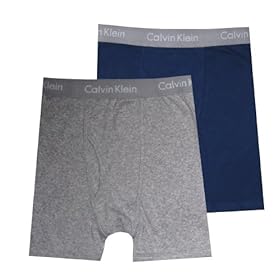In 1925, Jacob Golomb, founder of Everlast, designed elastic-waist trunks to replace the leather-belted trunks then worn by boxers. These trunks, now known as "boxer trunks", immediately became famous, but were later eclipsed by the popular Jockey-style briefs beginning in the late 1930s. Around 1947, boxer shorts started to gain in popularity again.[citation needed] The two styles, briefs and boxer shorts, had varying ratios of sales for the following forty years, with strong regional and generational preferences.
In more recent decades, boxer shorts got a fashion boost in 1984 when English model and musician Nick Kamen stripped to blue boxers in a 1950s style "Launderette" in a Levi's commercial. Since the 1990s, some men also opt for boxer briefs as a compromise between the two.
Most boxer shorts have a fly in front. Boxer shorts manufacturers have a couple of methods of closing the fly: metal snaps or a button or two. However, many boxer shorts on the market do not need a fastening mechanism to close up the fly as the fabric is cut and the shorts are designed to sufficiently overlap and fully cover the opening. This is commonly known as an open fly design.
Since boxer shorts fabric is rarely stretchy, a "balloon seat", a generous panel of loosely-fitting fabric in the center rear of the shorts, is designed to accommodate the wearer's various movements, especially bending forward. The most common sewing design of boxer shorts are made with a panel seat that has two seams running on the outer edges of the back seating area, creating a center rear panel. Most mass produced commercial boxer shorts are made using this design.
Two less common forms of boxer shorts are "gripper" boxers and "yoke front" boxers. Gripper boxers have an elastic waistband like regular boxers but have snaps, usually 3, on the fly and on the waistband so that they open up completely. Yoke front boxers are similar to gripper boxers in that the wide waistband yoke can be opened up completely, and the yoke usually has three snaps to close it while the fly itself, below, has no closure mechanism. There are two types of yoke boxers: one in which there is a short piece of elastic on each side of the waistband which snugs up the yoke to fit the waist; and "tie-sides" which have narrow cloth tapes on each side of the waist yoke, like strings, which are tightened and knotted by the wearer to make an exact fit. This style of underwear was very common during World War II, when the rubber needed for elastic waistbands had to be used for military purposes.
Boxer shorts are available in white and solid colors including pastels, and come in a variety of patterns and prints as well; Traditional patterns include "geometrics" (small repeating geometric designs), plaids and vertical stripes. Additionally, there are innumerable "novelty" boxer short patterns. Boxer shorts are produced using various fabrics including all cotton, cotton/polyester blends, jersey knits and silk.
Some studies have suggested that tight underwear and high temperature are bad for sperm. The reasoning is based on the following: the testicles are outside the body for cooling because they operate for sperm production at a lower temperature than the rest of the body, and boxer shorts allow the testes to operate within the required temperature range. The compression of the genitals in briefs may cause the temperature to rise and sperm production to fall. This is a similar theory regarding testicular cancer risk.
In 1975, an advertisement for boxer shorts created a recurring urban legend. The fall/winter Sears catalogue displayed two underwear models, one wearing briefs and another wearing boxer shorts. The model wearing the boxer shorts appears to have part of his penis (some sources say a testicle) exposed. At the time, this caused a stir because of possible indecent exposure. However, Sears states that it is a printing defect and the same ad reappeared in color in a later catalogue, where no penis is shown. Despite the publicity, Sears did not release a copy of the colored ad to allow the public to verify its statement. Without the proof, the urban legend still persists in popular culture.
References
http://en.wikipedia.org/wiki/Boxer_shorts
